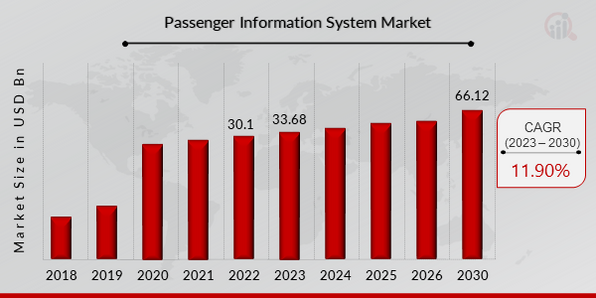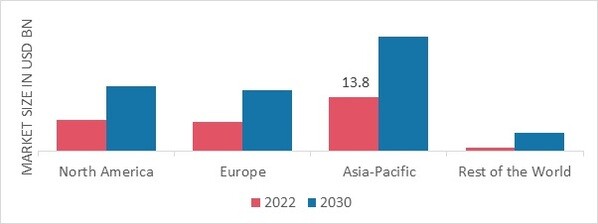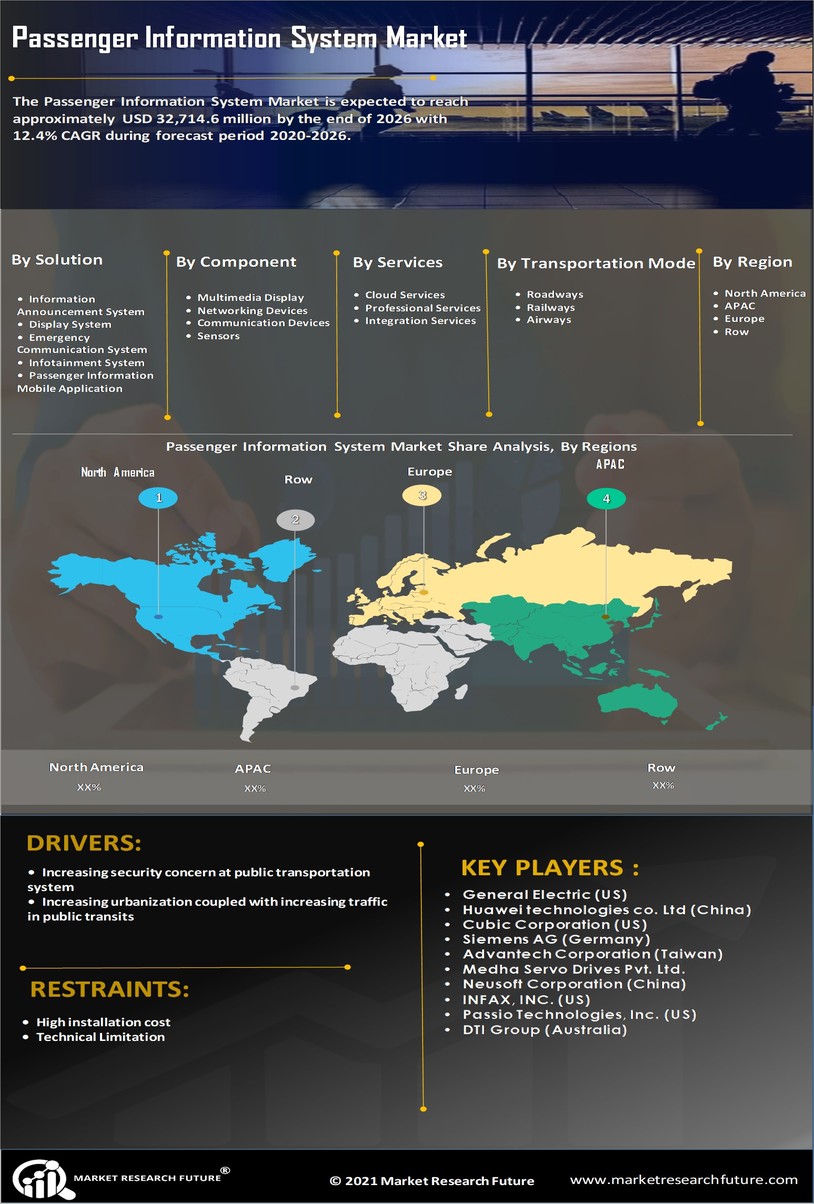Passenger Information System Market Overview
Passenger Information System Market Size was valued at USD 30.1 billion in 2022. The Passenger Information System market is projected to grow from USD 33.6819 Billion in 2023 to USD 66.12673 billion by 2030, exhibiting a compound annual growth rate (CAGR) of 11.90% during the forecast period (2023 - 2030). The increase in the usage of smartphones and growth in the use of big data and the cloud are the key market drivers enhancing market growth.
Figure 1: Passenger Information System Market Size, 2023-2030 (USD Billion)
Source Secondary Research, Primary Research, MRFR Database and Analyst Review
Passenger Information System Market Trends
- Increase in the usage of smartphones is driving the market growth
Due to the growing use of smartphones, mobile application-based passenger information systems are quickly gaining ground. Additionally, in June 2018, approximately 5.3 billion distinct mobile subscribers were registered, representing a 3.5% YoY growth. Additionally, transit agencies are concentrating on mobile PIS applications to draw customers and give them quick, accurate real-time information via smartphone channels. A further opportunity for market expansion is the emergence of multi-modal transit apps for public transportation.
The automation of various forms of transportation, particularly railroads, is facilitated by the use of cloud computing. The passenger information system tracks the locations of buses in the area. Cloud computing technology determines the arrival time to be displayed on the real-time information system at the bus stop. It is possible to allocate resources with high efficiency and monitor the passenger population economically with the help of cloud technology and data analytics solutions.
The passenger information system (PIS) is a solution that offers travelers useful real-time information about the status of transportation options like trains, buses, and airplanes. At stations and other transfer facilities, the operating tool offers passengers an audible and visual means of communication. It entails managing information about routes using a variety of platforms, including screens, indicator panels, and others. The demand for passenger information systems will increase as more and more transportation companies strive to give customers accurate and reliable real-time travel information. Some market growth drivers include the rising use of mobile devices, the internet, and the need for passengers and travelers to look for factual information to improve connectivity and safe travel.
Data can now be shared among various technological devices without direct human intervention thanks to the Internet of Things (IoT). The market for passenger information systems is growing due to developments in the telecommunications sector that enable faster data transfer capabilities, rising IoT usage in the transportation industry, and demand for intelligent transportation systems. Thus, driving the Passenger Information System market revenue.
Passenger Information System Market Segment Insights
Passenger Information System Component Insights
Based on components, the Passenger Information System Market segmentation includes networking devices, sensors, multimedia displays, and communication devices. The communication devices segment dominated the market, and the expansion can be attributed to the rise in demand for the hardware and software tools needed for transportation infrastructure. As a result, passengers can access information both physically inside a vehicle and remotely via mobile applications or web browsers has enhanced the Passenger Information System market CAGR across the globe in recent years.
Passenger Information System Transportation Mode Insights
Based on transportation mode, the Passenger Information System Market segmentation includes railways, airways, and roadways. The roadways segment held the majority share in 2022 concerning the Passenger Information System Market revenue. However, the railway segment is anticipated to expand significantly over the forecast period. Asia-Pacific is additionally predicted to exhibit high growth rates due to the region's high demand for passenger information systems.
Passenger Information System Solution Insights
Based on the Solution, the Passenger Information System Market data includes a display system, an infotainment system, an information announcement system, a passenger information mobile application, an emergency communication system, and others. The passenger information mobile application category generated the most income due to the increased use of smartphones. Furthermore, with a Y-o-Y growth of about 3.5% in June 2018, approximately 5.3 billion unique mobile subscribers were registered. Additionally, transit agencies are putting much effort into PIS mobile applications to draw in customers and give them access to quick, accurate real-time information via smartphone channels. Developing multi-modal transit apps for public transportation is also advantageous for expanding implants for Passenger Information Systems, positively impacting the market growth.
Figure 2: Passenger Information System Market by Transportation Mode, 2022 & 2030 (USD billion)
 Source Secondary Research, Primary Research, MRFR Database and Analyst Review
Source Secondary Research, Primary Research, MRFR Database and Analyst Review
Passenger Information System Services Insights
Based on the services, the global passenger information system industry includes professional, cloud, and integration services. Cloud services dominate the market holding the maximum market share during the forecasted period. Different transportation modes, particularly railroads, are automated with the help of cloud computing. The bus stop's real-time information system at the bus stop receives real-time data from the passenger information system, which tracks the locations of nearby buses and calculates the arrival time for display. Cloud computing and data analytics tools help deliver high resource allocation efficiency and cost-effective passenger population monitoring.
Passenger Information System Regional Insights
By Region, the study provides market insights into North America, Europe, Asia-Pacific and the Rest of the World. The Asia Pacific Passenger Information System market will dominate this market due to government initiatives regarding transportation services, technological advancements, and the growing adoption of real-time information systems. Furthermore, as an example, the region's increased use of public transportation and investments in metro rail projects are speeding up APAC's growth. In the Union Budget for 2021, the Indian government allocated over USD 33 billion for improving transportation infrastructure, and an additional USD 2.61 billion was allocated for metro projects. It will boost the market growth in this region.
Further, the major countries studied in the market report are The U.S., Canada, German, France, the UK, Italy, Spain, China, Japan, India, Australia, South Korea, and Brazil.
Figure 3: PASSENGER INFORMATION SYSTEM SHARE BY REGION 2022 (%)
 Source Secondary Research, Primary Research, MRFR Database and Analyst Review
Source Secondary Research, Primary Research, MRFR Database and Analyst Review
Europe’s Passenger Information System market accounts for the second-largest market share. This is due to the increase in the automation of various forms of transportation, particularly railroads, facilitated by cloud computing. The passenger information system tracks the locations of buses in the area. Cloud computing technology determines the arrival time to be displayed on the real-time information system at the bus stop. Further, the German Passenger Information System market held the largest market share, and the UK Passenger Information System market was the fastest-growing market in the European region.
The North America Passenger Information System Market is expected to grow at the fastest CAGR from 2023 to 2030 due to a greater focus on developing transportation infrastructure and significant investments in intelligent transportation systems by the private and public sectors. The leading nations in the region in terms of investments and transportation initiatives are the United States and Canada. October 2018 saw the U.S. S. The Department of Transportation invest about USD 63.9 billion in significant transportation infrastructure across America. Moreover, the US Passenger Information System market held the largest market share, and the Canada Passenger Information System market was the fastest-growing market in the North American region.
Passenger Information System Key Market Players & Competitive Insights
Leading market players are investing heavily in research and development to expand their product lines, which will help the Passenger Information System market grow even more. Market participants are also undertaking various strategic activities to expand their Global footprint, with important market developments including new product launches, contractual agreements, mergers and acquisitions, higher investments, and collaboration with other organizations. To expand and survive in a more competitive and rising market climate, the Passenger Information System industry must offer cost-effective items.
Manufacturing locally to minimize operational costs is one of the key business tactics manufacturers use in the Global Passenger Information System industry to benefit clients and increase the market sector. The Passenger Information System industry has recently offered some of the most significant medical advantages. Major players in the Passenger Information System market, including Huawei Technologies Co. Ltd (China), SAMSUNG (South Korea), Komachine.com, Co. (South Korea), Mitsubishi Electric Corporation (Japan) and others, are attempting to increase market demand by investing in research and development operations.
Huawei Technologies Co. Ltd (China) was established in 1987 and is now a major player in smart devices and ICT infrastructure. Serving more than three billion people worldwide, we employ about 195,000 people and operate in more than 170 nations and regions. Huawei aims to create a fully connected, intelligent world by bringing digital technology to every individual, home, and organization. To achieve this, we will push for widespread connectivity and advocate for open access to networks to lay the groundwork for an intelligent world; we will also provide diversified computing power to deliver ubiquitous cloud and intelligence; we will build robust digital platforms to aid all industries and organizations in becoming more agile, efficient, and dynamic; and we will redefine user experience with AI, offering users a more personalized and intelligent experience across all scenarios, including home.
SAMSUNG (South Korea), the Samsung Electronics Co., Ltd., produces and distributes mobile products like smartphones and tablets and consumer electronics like TVs, monitors, printers, refrigerators, and washing machines. The company's operations are divided into three business segments IT and mobile communications (IM) operates mobile communications, networks, and digital imaging businesses with a focus on the production and sale of mobile phones, including smartphones and multimedia phones, as well as information communications and technology (ICT) systems, and cameras; consumer electronics (CE) runs businesses that provide visual displays, digital appliances, business printing solutions, and health and medical equipment. Galaxy Electronics Co., Ltd. operates as a division of the Samsung Group. The business is headquartered in Suwon, Gyeonggi-do Province, South Korea. Electronics giant Samsung Co., Ltd. became a corporation in 1969.
Key Companies in the Passenger Information System market include
- Huawei Technologies Co. Ltd (China)
- SAMSUNG (South Korea)
- com (South Korea)
- Mitsubishi Electric Corporation (Japan)
Passenger Information System Industry Developments
August 2021 IATA, the international air transport association, projects that in 2021, the airline industry will lose about USD 47.7 billion annually. This is an improvement compared to the $126.4 billion net industry loss predicted for 2020.
September 2022 The purchase of EKE-Electronics Ltd. by Mitsubishi Electric Corporation was announced, a producer of informational systems for trains in Finland. Through this acquisition, Mitsubishi Electric will be able to expand its business partnership with EKE-Electronics and grow its train passenger information systems sector in international markets.
January 2021 Trials for an AI-based demand-responsive ridesharing system are being launched by Toshiba Digital Solutions and JUNPUZI, which will help with transportation access issues and promote community redevelopment. The company's technology and portfolio were both expanded due to this acquisition.
Passenger Information System Market Segmentation
Passenger Information System Component Outlook
- Networking devices
- Sensors
- Multimedia display
- Communication devices
- Others
Passenger Information System Transportation Mode Outlook
- Railways
- Airways
- Roadways
Passenger Information System Solution Outlook
- Display system
- Infotainment system
- Information announcement system
- Passenger information mobile application
- Emergency communication system
- Others
Passenger Information System Services Outlook
- Professional Services
- Cloud services
- Integration Services
Passenger Information System Regional Outlook
-
North America
-
Europe
- Germany
- France
- UK
- Italy
- Spain
- Rest of Europe
-
Asia-Pacific
- China
- Japan
- India
- Australia
- South Korea
- Australia
- Rest of Asia-Pacific
-
Rest of the World
- Middle East
- Africa
- Latin America
| Report Attribute/Metric |
Details |
| Market Size 2022 |
USD 30.1 billion |
| Market Size 2023 |
USD 33.6819 billion |
| Market Size 2030 |
USD 66.12673 billion |
| Compound Annual Growth Rate (CAGR) |
11.90% (2023-2030) |
| Base Year |
2022 |
| Market Forecast Period |
2023-2030 |
| Historical Data |
2019- 2021 |
| Market Forecast Units |
Value (USD Billion) |
| Report Coverage |
Revenue Forecast, Market Competitive Landscape, Growth Factors, and Trends |
| Segments Covered |
Component, Transportation Mode, Solutions, Services and Region |
| Geographies Covered |
North America, Europe, Asia Pacific, and the Rest of the World |
| Countries Covered |
The U.S., Canada, German, France, the UK, Italy, Spain, China, Japan, India, Australia, South Korea, and Brazil |
| Key Companies Profiled |
Huawei Technologies Co. Ltd (China), SAMSUNG (South Korea), Komachine.com, Co. (South Korea), Mitsubishi Electric Corporation (Japan) |
| Key Market Opportunities |
The increase in the usage of smartphones |
| Key Market Dynamics |
Growth in the use of big data and the cloud |
Passenger Information System Market Highlights:
Frequently Asked Questions (FAQ) :
The Passenger Information System Market size was valued at USD 30.1 Billion in 2022.
The global market is projected to grow at a CAGR of 11.90% during the forecast period, 2023-2030.
Asia Pacific had the largest share of the global market
The key players in the market are Huawei Technologies Co. Ltd (China), SAMSUNG (South Korea), Komachine.com, Co. (South Korea), and Mitsubishi Electric Corporation (Japan).
The communication devices passenger information system category dominated the market in 2022.
The roadways channel had the largest share of the global market.







 Source Secondary Research, Primary Research, MRFR Database and Analyst Review
Source Secondary Research, Primary Research, MRFR Database and Analyst Review Source Secondary Research, Primary Research, MRFR Database and Analyst Review
Source Secondary Research, Primary Research, MRFR Database and Analyst Review




















